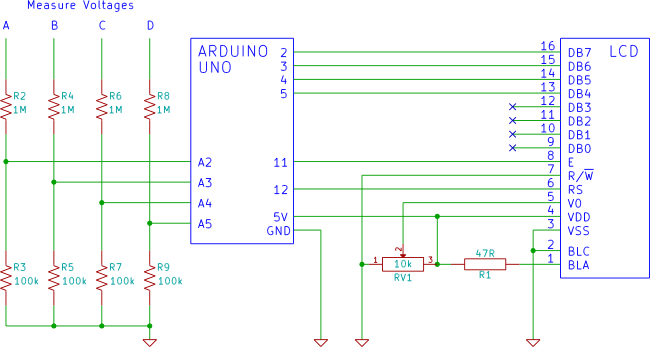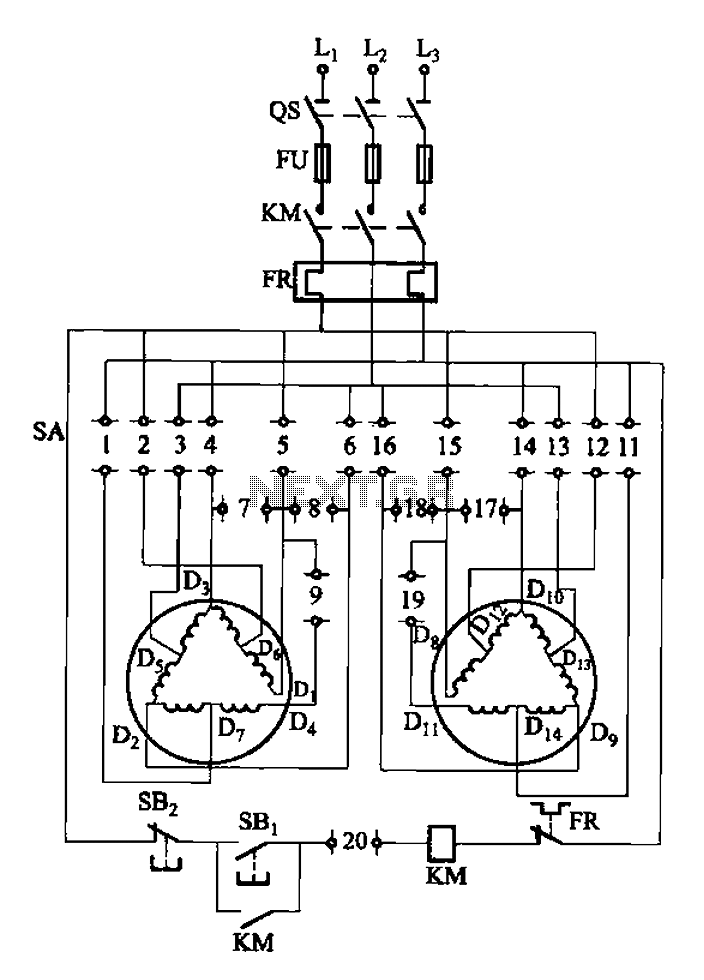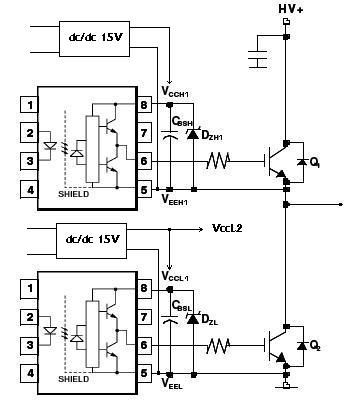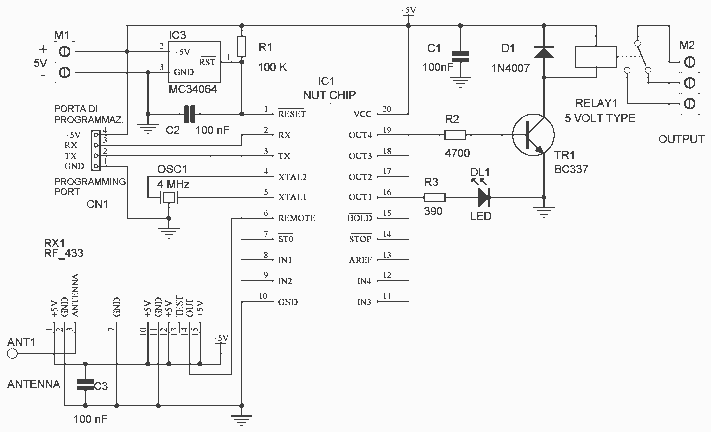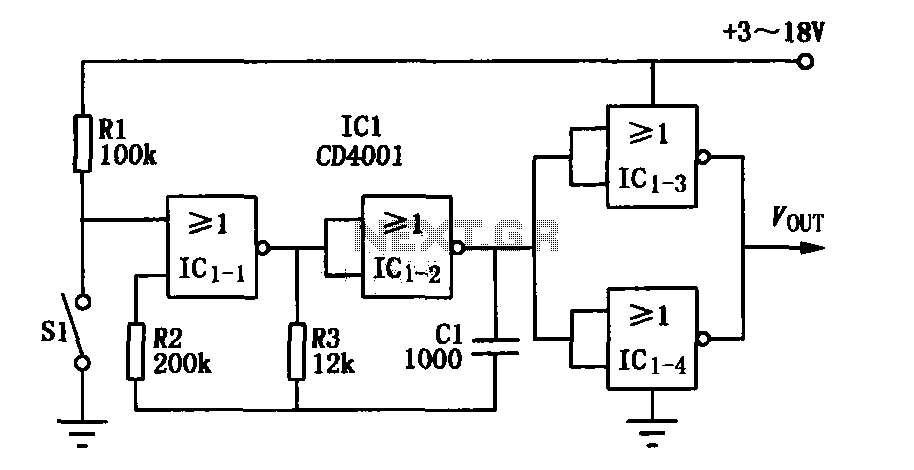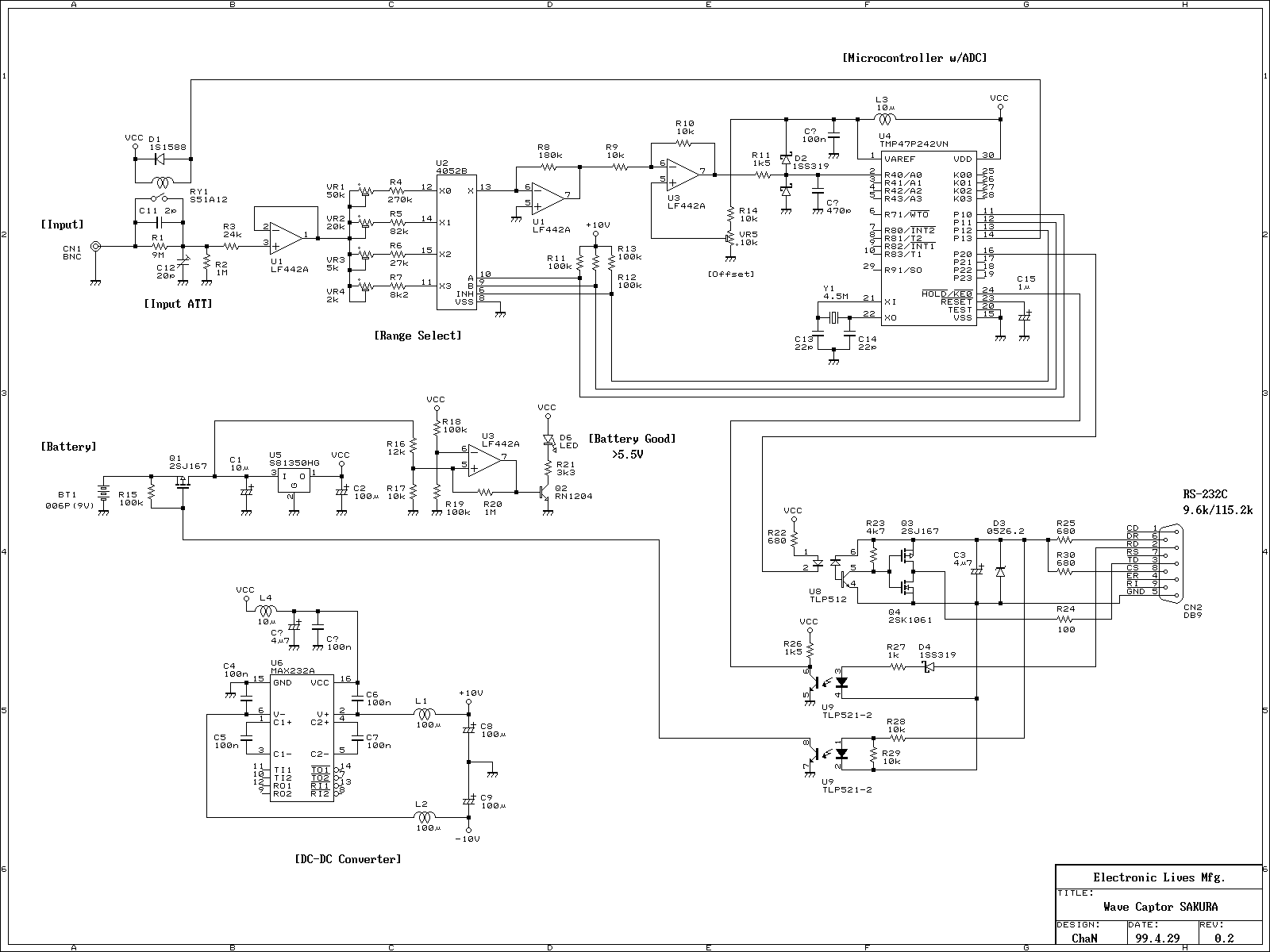
four channel oscilloscope
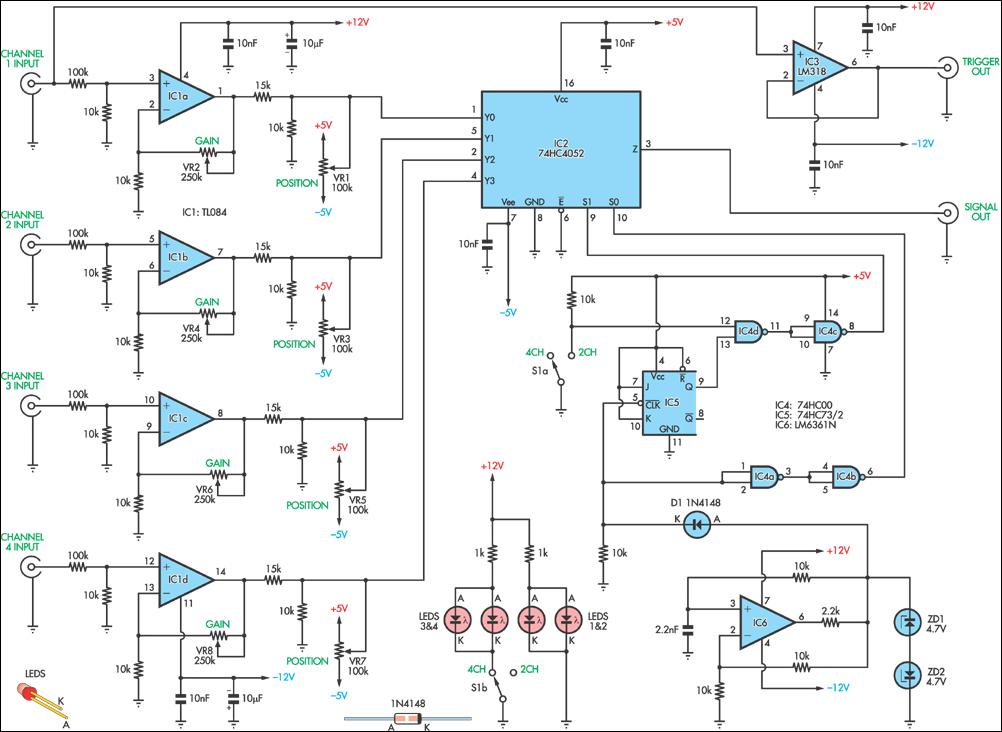
This circuit allows the simultaneous display of four signals using only one channel of an oscilloscope. It sequentially switches each input to the output while performing some signal conditioning. This configuration is designed for low-frequency signal measurements and lacks over-voltage protection at the inputs. Each input circuit is identical and utilizes one amplifier from a TL084 quad op-amp package. For channel 1, the input signal is attenuated by a factor of 10 using a 100kΩ and a 10kΩ resistor before reaching the non-inverting input of IC1a. A 15kΩ resistor in series with the op-amp output, along with a 10kΩ resistor to ground, provides additional attenuation. Vertical adjustment is facilitated by VR2, which sets the gain of the amplifier. This adjustment allows for calibration or scaling of the displayed signal against the actual input voltage level. With the specified values, the gain can be adjusted from unity to approximately 26. The output of the op-amp must be limited to ±10V to ensure that the voltage into the 4-channel multiplexer (IC2) does not exceed ±5V. Consequently, with a gain of unity, the input voltage can range from ±100V, whereas with a gain of 26, it must not exceed about ±3.85V. VR1 applies a positive or negative DC offset to the output of the op-amp, which can compensate for input offset voltage and shift the vertical position of the trace on-screen for multiple trace separation. However, any offset will reduce the available output swing and limit measurement "headroom." Each op-amp output connects to IC2, a 4-channel analog multiplexer. The logic levels on "S0" and "S1" (pins 9 and 10) determine which input channel is connected to the "Z" output (pin 3). A square wave oscillator and divider circuit toggle the "S0" and "S1" pins in sequence to select each channel briefly. An LM6361 high-speed op-amp (IC6) serves as the oscillator, operating at about 20kHz. Back-to-back zener diodes at the output clip the voltage to TTL levels, and diode D1 passes the positive half-cycle to the input of one gate of a 74HC00 quad NAND device. IC4a and IC4b clean the signal before it is applied to the S0 input of IC2. A 74HC73 J-K flip-flop (IC5) divides the oscillator frequency by two, driving the "S1" input in 4-channel mode. In 2-channel mode (with switch S1 closed), one input (pin 12) of IC4d is pulled low, holding the "S1" input permanently low. A separate buffer circuit (IC3) provides a trigger signal for the oscilloscope, as triggering reliably on the main output would be challenging due to rapid switching between the four signal sources.
This circuit is designed to facilitate the simultaneous observation of multiple signals, making it particularly useful in applications where low-frequency signals need to be analyzed in a compact manner. The use of the TL084 op-amps ensures low noise and high precision in signal processing. The attenuation and gain adjustment capabilities allow for a wide range of input signal levels, which enhances the circuit's versatility. The integration of an analog multiplexer (IC2) enables efficient channel selection without the need for multiple oscilloscope inputs, thereby streamlining the measurement process.
The oscillator circuit, based on the LM6361, is crucial for generating the timing signals required for channel switching. The frequency of approximately 20kHz is suitable for low-frequency applications, ensuring that the switching does not interfere with the integrity of the signals being observed. The inclusion of zener diodes for voltage clamping protects the logic circuitry from over-voltage conditions, maintaining the integrity of the logic levels used to control the multiplexer.
In conclusion, this circuit provides a robust solution for low-frequency signal measurement, combining effective signal conditioning, precise gain control, and efficient channel multiplexing, making it ideal for various electronic testing and analysis applications.This circuit enables you to display four signals simultaneously using only one channel of your oscilloscope. Essentially, it switches each of the inputs through to the output in turn, with some signal massaging in between.
As shown, it is suitable only for low-frequency signal measurement and does not include over-voltage protection at the inputs. Each input circuit is identical, utilising one amplifier from a TL084 quad op amp package. Looking at channel 1, the input signal is attenuated by a factor of 10 by the 100k © and 10k © resistors before arriving at the non-inverting input of IC1a. A 15k © resistor in series with the op amp output along with a 10k © resistor to ground provide additional attenuation.
Vertical (voltage axis) adjustment is made with VR2, which sets the gain of the amplifier. This is used to calibrate or scale the displayed signal against the actual input voltage level. Using the values shown, the gain can be adjusted from unity to about a factor of 26. Note that the output of the op amp must be limited to ± 10V so that the voltage into the 4-channel multiplexer (IC2) does not exceed ± 5V. Therefore, with a gain of unity, the input voltage can range from ± 100V, whereas with a gain of 26, it must not exceed about ± 3.
85V. VR1 applies a positive or negative DC offset to the output of the op amp. This can be used to compensate for op amp input offset voltage. It can also be used to shift the vertical position of the trace on-screen to provide multiple trace separation. Note, however, that any offset will consume part of the available output swing and therefore limit signal measurement "headroom".
Each op amp output is connected to IC2, a 4-channel analog multiplexer. The logic levels on "S0" & "S1" (pins 9 & 10) determine which input channel is connected to the "Z" output (pin 3). A square wave oscillator and divider circuit are used to toggle the "S0" and "S1" pins in sequence to first select channel 1 briefly, then channel 2 and so on.
An LM6361 high-speed op amp (IC6) forms the heart of the oscillator. It operates at about 20kHz. Back-to-back zener diodes at the output clip the voltage to TTL levels, after which diode D1 passes the positive half-cycle to the input of one gate of a 74HC00 quad NAND device. IC4a & IC4b "clean up" the signal before if is applied to the S0 input of IC2. A 74HC73 J-K flip-flip (IC5) divides the oscillator frequency by two. This is used to drive the "S1" input when in 4-channel mode. In 2-channel mode (switch S1 closed), one input (pin 12) of IC4d is pulled low, which effectively holds the "S1" input permanently low.
Finally, a separate buffer circuit (IC3) is used to provide a trigger signal for the oscilloscope. This is needed because it would be difficult to trigger reliably on the main output as it switches rapidly between the four signal sources. 🔗 External reference
This circuit is designed to facilitate the simultaneous observation of multiple signals, making it particularly useful in applications where low-frequency signals need to be analyzed in a compact manner. The use of the TL084 op-amps ensures low noise and high precision in signal processing. The attenuation and gain adjustment capabilities allow for a wide range of input signal levels, which enhances the circuit's versatility. The integration of an analog multiplexer (IC2) enables efficient channel selection without the need for multiple oscilloscope inputs, thereby streamlining the measurement process.
The oscillator circuit, based on the LM6361, is crucial for generating the timing signals required for channel switching. The frequency of approximately 20kHz is suitable for low-frequency applications, ensuring that the switching does not interfere with the integrity of the signals being observed. The inclusion of zener diodes for voltage clamping protects the logic circuitry from over-voltage conditions, maintaining the integrity of the logic levels used to control the multiplexer.
In conclusion, this circuit provides a robust solution for low-frequency signal measurement, combining effective signal conditioning, precise gain control, and efficient channel multiplexing, making it ideal for various electronic testing and analysis applications.This circuit enables you to display four signals simultaneously using only one channel of your oscilloscope. Essentially, it switches each of the inputs through to the output in turn, with some signal massaging in between.
As shown, it is suitable only for low-frequency signal measurement and does not include over-voltage protection at the inputs. Each input circuit is identical, utilising one amplifier from a TL084 quad op amp package. Looking at channel 1, the input signal is attenuated by a factor of 10 by the 100k © and 10k © resistors before arriving at the non-inverting input of IC1a. A 15k © resistor in series with the op amp output along with a 10k © resistor to ground provide additional attenuation.
Vertical (voltage axis) adjustment is made with VR2, which sets the gain of the amplifier. This is used to calibrate or scale the displayed signal against the actual input voltage level. Using the values shown, the gain can be adjusted from unity to about a factor of 26. Note that the output of the op amp must be limited to ± 10V so that the voltage into the 4-channel multiplexer (IC2) does not exceed ± 5V. Therefore, with a gain of unity, the input voltage can range from ± 100V, whereas with a gain of 26, it must not exceed about ± 3.
85V. VR1 applies a positive or negative DC offset to the output of the op amp. This can be used to compensate for op amp input offset voltage. It can also be used to shift the vertical position of the trace on-screen to provide multiple trace separation. Note, however, that any offset will consume part of the available output swing and therefore limit signal measurement "headroom".
Each op amp output is connected to IC2, a 4-channel analog multiplexer. The logic levels on "S0" & "S1" (pins 9 & 10) determine which input channel is connected to the "Z" output (pin 3). A square wave oscillator and divider circuit are used to toggle the "S0" and "S1" pins in sequence to first select channel 1 briefly, then channel 2 and so on.
An LM6361 high-speed op amp (IC6) forms the heart of the oscillator. It operates at about 20kHz. Back-to-back zener diodes at the output clip the voltage to TTL levels, after which diode D1 passes the positive half-cycle to the input of one gate of a 74HC00 quad NAND device. IC4a & IC4b "clean up" the signal before if is applied to the S0 input of IC2. A 74HC73 J-K flip-flip (IC5) divides the oscillator frequency by two. This is used to drive the "S1" input when in 4-channel mode. In 2-channel mode (switch S1 closed), one input (pin 12) of IC4d is pulled low, which effectively holds the "S1" input permanently low.
Finally, a separate buffer circuit (IC3) is used to provide a trigger signal for the oscilloscope. This is needed because it would be difficult to trigger reliably on the main output as it switches rapidly between the four signal sources. 🔗 External reference
